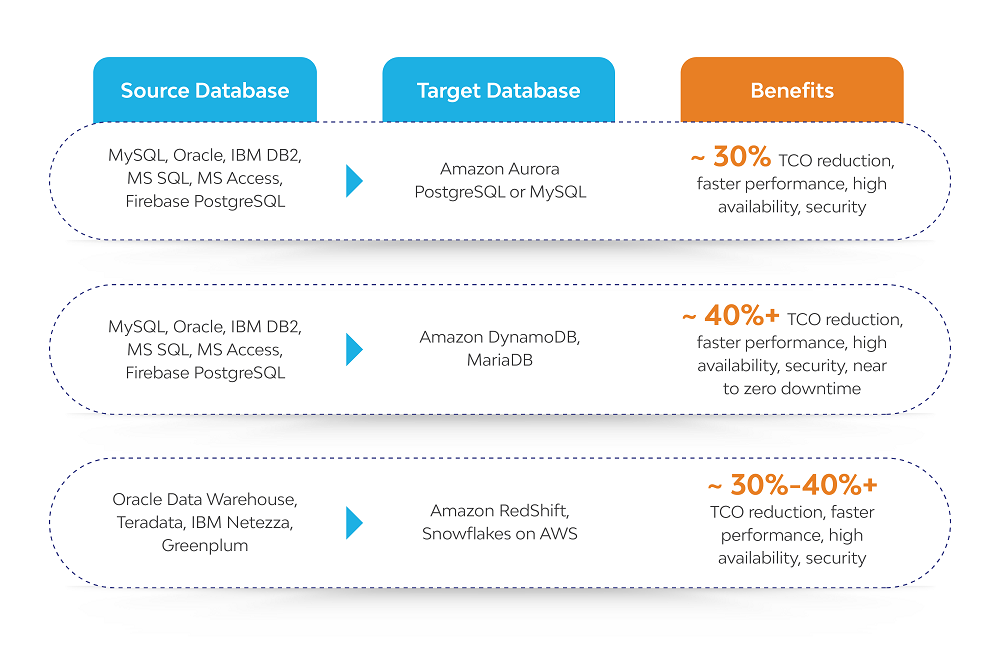Top 10 AWS Trends To Look for in 2022
Explore the top 10 AWS trends in 2022. This blog covers recent trends in cloud computing that can help enterprises to build the right roadmap for their cloud enablement journey.
Enterprises are adopting cloud services aggressively. Among the current trends, the demand for migration to AWS has increased exponentially due to tremendous benefits such as cost, security, scalability, time to market, and accelerated innovation.
Here are the top trends in application modernization and migration to AWS cloud for 2022.
1. Low-Code Development is on the Rise
In 2022, customers are adopting a low-code approach for building customer-facing web apps, data collection apps, business workflow processes, and automation use cases to accelerate digital transformation initiatives. This low-code platform enables IT professionals, to spend less time on trivial use cases and spend more time on business-critical and complex use cases. AWS Amplify Studio helps to accelerate cloud-native application development with minimal or low code changes. Enterprises need to evaluate low code platforms against business functionality for targeted use cases, application maintenance costs, vendor lock-ins, and expertise of technical or non-technical teams, which are expected to work on these platforms and gain benefits promised by these platforms.
2. Modernization of Mainframe Applications to Cloud Native
Enterprises in the banking, insurance, and manufacturing industries are willing to modernize mainframe workloads to a cloud-native architecture. They want to increase scalability for business growth and agility in delivering new business functionality to remain competitive. They want to lower the cost of ownership over a period.
However, enterprises are reluctant to devise any strategy around mainframe workload migration to the cloud because of various challenges, such as:
- Complex, tightly coupled monolithic architecture with millions of lines of code.
- Use of architecture anti-patterns.
- Lack of functional and technical documentation.
- High risk in disturbing core business functionality running on mainframe workload.
Many mainframe migration projects are often interrupted or abandoned due to longer project execution times, a high risk of failure during migration, and higher modernization costs.
AWS has recently announced mainframe modernization competency and tools to migrate mainframe workloads at reduced modernization cost, shorter project duration, and lower project risks. These tools help to automate the discovery of mainframe source code and auto-refactor source code to advanced programming languages as per the modern engineering best practices and migrate mainframe data to AWS databases.
3. Decarbonization and Sustainable Development using Serverless
The energy industry is building aggressive strategies for decarbonization and IT transformation. These enterprises are adopting the cloud for building effective customer-facing web applications, distributed or smart grid solutions, and data integration capabilities using a serverless architecture.
Public cloud providers like AWS are 70-80% more power-efficient than on-premises data centers due to elastic scaling, containerization, and serverless capabilities being offered by these providers. The right selection of cloud provider, serverless platform, and containerization technology is crucial for the energy industry to meet its decarbonization goals while executing IT transformations and cloud migration initiatives.
4. Industry-Focused Vertical Solutions to Accelerate Innovation
Every enterprise has its unique regulatory, governance, and legacy technology challenges when it comes to migrating workloads to the public cloud. Enterprises in the financial services and healthcare industries have strict regulation and privacy requirements, whereas enterprises in the energy industry are more aggressive on decarbonization and distributed integration requirements.
Public cloud providers such as AWS have come up with unique value propositions to provide tailored services to address the specific needs of high-valued financial services, healthcare, and energy organizations to accelerate cloud enablement. Since every customer portfolio and application requirements are unique, enterprises may consider a hybrid approach as a traditional cloud migration strategy may not work, or the latest technology might not be suitable to solve specific business problems.
5. Move from Commercial to Purposeful Cloud-Native Database
Enterprises are moving from commercial databases to purposeful cloud databases built on open-source platforms as these databases have reached parity with commercial databases in terms of features, tools, performances, and scale at lower TCO.
Enterprises are considering a purposeful cloud-native database as an alternative option, as illustrated in the below table:

Migration from commercial databases requires capabilities for complicated heterogeneous schema conversion, modification of in-compatible SQL queries, data replication and transformation, and migration of PL SQL source code.
A public cloud provider like AWS offers tools like SCT and DMS to accelerate database migration from commercial databases to purposeful cloud-native databases. These cloud-native databases are providing further cost savings by providing serverless options, which reduce the infrastructure cost of maintaining databases on the cloud.
6. Migration of Legacy Custom-Built Applications to Containers
Organizations are considering containerization technology to accelerate application workloads to the cloud to achieve scalability, portability, and cost benefits. Application migration to AWS containers can be accelerated at reduced risks with the help of DevSecOps, AIOps continuous integration, and deployment pipeline.
Custom build applications running on Java and .NET frameworks can run on the containers and serverless technologies supported on the AWS cloud, such as AWS Lambda, Amazon EKS, and Amazon ECS. In addition to this, Amazon ECS and Amazon EKS support both Windows and Linux-based containers. AWS App2 Container helps to analyze on-premise applications, build deployment artifacts, and deploy applications at scale to AWS containerization services.
7. Re-Platform Commercial Enterprise Integration Platform using AWS Serverless and Cloud-Native
Enterprise integration platforms are essential for enterprises to deliver enhanced customer experiences by integrating siloed data across landscapes, addressing compliance and regulatory requirements. Traditional integration platforms, such as IBM integration suits, MuleSoft, etc., are very expensive in terms of licenses and operational costs.
Over the past few years, cloud-native or serverless solutions provided by public cloud providers are becoming increasingly popular for implementing enterprise integration solutions as an alternative to monolith enterprise integration platforms such as IBM Integration Suites, MuleSoft ESB, etc. They reduce the cost of ownership, eliminate vendor locking, save development time, and provide better security and data handling.
8. Cloud for Innovation leveraging Technologies such as Edge Computing, IoT, and Blockchain
Innovation is at the core of accelerating business transformation and preventing future disruptions. Enterprises are using a mix of IoT, Edge Computing, and Blockchain technologies for reinvention in the cloud. Various industry-specific use cases involve IoT devices sending huge amounts of data to edge locations for doing analytics close to the users or devices.
These use cases require a Blockchain consensus algorithm to provide security guardrails to solve the security and privacy issues associated with edge computing and to ensure that data is coming from verified IoT devices and has not been tampered with. Edge Computing, IoT, and Blockchain capabilities offered by public cloud providers help enterprises to capitalize on opportunities for reinvention and growth.
9. Management of Multi-Cloud Through Cloud-Ops
Enterprises are adopting multi-cloud strategies for migrating application workloads to use best-of-the-breed cloud services targeting specific use cases. The multi-cloud decisions usually lead to increased complexity as each cloud provider has different security and governance systems, and a widespread of different options for serverless, containerization, databases, big data, analytics, and other services.
Enterprises adopting a multi-cloud strategy need to build common cross-cloud services or platforms to improve the projected ROI reduce maintenance and operational costs, and mitigate failure risks. These common cross-cloud capabilities can be implemented by leveraging CloudOps or AIOps tooling and operation-specific technologies such as GitOps to manage a complex environment with lower cost and risk.
10. Securing Data on Cloud using ABAC
It is important for enterprises to safeguard and secure data on the cloud and prepare a data governance plan to manage data availability, integrity, and security requirements. Traditional role-based access control/IAM is not adequate to address the complex security needs of extended enterprises. Enterprises are building a centralized data security platform based on Attribute Based Access control (ABAC) to enforce data access decisions based on the attributes of subjects, resources, actions, and different personas involved in the data access. These security platforms are used in maintaining and managing security policies for data access, encrypting sensitive data, and auditing data access. Enterprises are adopting Open-source platforms like Impala along with the Kerberos authentication framework to secure big data workload in the multi-cloud environment.
Conclusion
Migration strategy offers many benefits to organizations, such as lower TCO, enhanced security and scalability, improved performance, and addressing regulatory and compliance requirements while driving innovation. Therefore, the adoption of migration strategy is likely to increase significantly going ahead as well.
It is important to understand that every enterprise has a unique application portfolio and business use case requirements. With proper application migration discovery, planning, and using the right tools and accelerators, you should be able to rapidly modernize and migrate your application portfolio to get the full benefits of the cloud.
If you would like to chat with an expert on how AWS can help your business stay competitive, drop us a note at cloud.communications@ltimindtree.com.
More from Girish Tandel
Latest Blogs
A closer look at Kimi K2 Thinking, an open agentic model that pushes autonomy, security, and…
We live in an era where data drives every strategic shift, fuels every decision, and informs…
The Evolution of Third-Party Risk: When Trust Meets Technology Not long ago, third-party risk…
Today, media and entertainment are changing quickly. The combination of artificial intelligence,…




